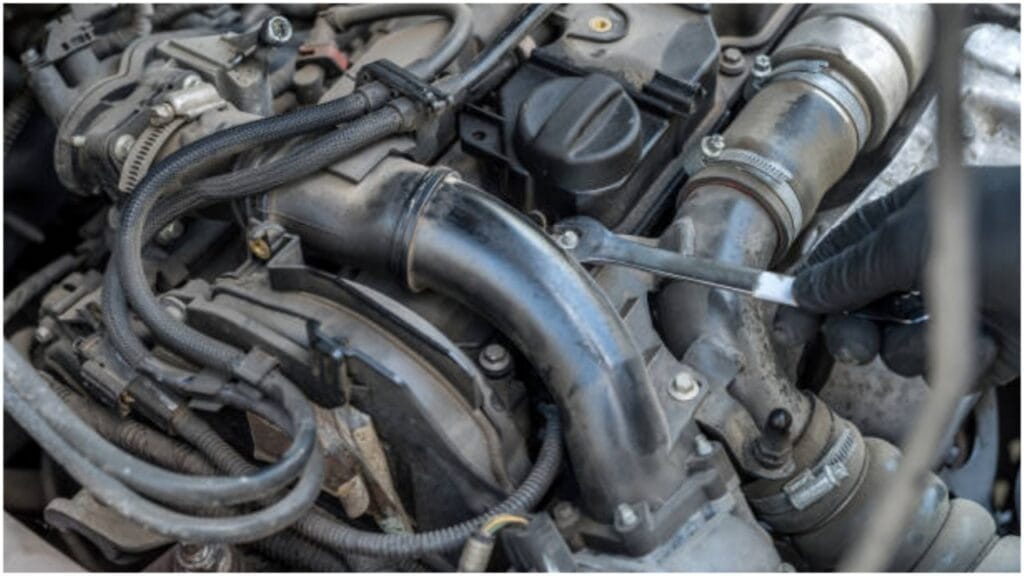When your car has a vacuum leak, strange problems can arise. The engine might idle roughly, the check engine light blink or the fuel economy might plummet. A vacuum leak allows unmetered air into the engine, messing with the air-fuel mixture.
Why Propane?
Propane is used because it’s flammable and reacts quickly. When introduced near a vacuum leak, it gets sucked into the engine. This alters the engine’s idle speed or sound. It’s a quick way to pinpoint the trouble spot.
How the Propane Test Works
The propane method is straightforward. You’ll need a small propane torch. Ensure the torch is off. Then, guide the nozzle around the vacuum, intake manifold seals, and other areas prone to leaks.
As the propane gets sucked into the engine, you’ll notice a change. Usually, the engine revs up slightly or idles differently. This indicates you’re close to the leak.
Is It Safe?
Safety is a common concern with this method. Propane is flammable, and using it near a hot engine or open spark could be dangerous. Always ensure the engine is cool and avoid areas with potential sparks.
Keep a fire extinguisher nearby. Propane is heavier than air, so use it cautiously in enclosed spaces. Good ventilation minimizes risks.
Steps to Follow
- Start the engine and let it idle. Ensure it’s running stable.
- Use a propane torch with the flame off. Turn on the gas flow slightly.
- Slowly move the nozzle around the intake manifold, hoses, and other suspect areas.
- Listen carefully. A change in engine sound signals you’ve found a leak.
Common Vacuum Leak Areas
- Intake manifold gaskets
- Vacuum hoses
- Throttle body seals
- PCV valve connections
Checking these areas with propane increases the chances of finding the issue.
Why Not Soapy Water?
Some people use soapy water to detect vacuum leaks. This method works for external parts but struggles with deeper issues. Propane is better for finding leaks within the engine.
After Finding the Leak
Once you locate the problem, turn off the engine. Inspect the damaged part closely. If it’s cracked, replace it. If it’s a gasket, consider a professional repair.
Alternative Methods
If propane feels risky, try carb cleaner or smoke testing. These methods are also effective and feel safer for some.
Understanding Vacuum Leaks
A vacuum leak can sneak up on your car. It happens when unwanted air enters the engine’s intake system. This disrupts the balance of air and fuel, leading to performance problems. Engines rely on precise air-to-fuel ratios to run smoothly.
The Role of Propane
Propane works because it’s volatile. It’s drawn into any opening, even tiny ones. When it enters the engine, the idle changes immediately. This reaction is what makes it useful for detecting leaks.
Propane doesn’t harm engine components when appropriately used. It’s safe for seals and connections, so many DIY mechanics trust this method.
Testing on a Cool Engine

Always start with a cold engine. Heat increases the risk of accidents with propane. Avoid using it near open flames or heated surfaces.
A cold engine also helps you work comfortably. It’s easier to inspect parts closely without the risk of burns.
Listening for Changes
When using propane, listen carefully. A steady engine idle is normal. If the engine stumbles or revs up, it signals a leak. This sound is your key to pinpointing the issue.
Take your time with the process. Slowly move the propane around potential problem areas. Rushing can cause you to miss small leaks.
What to Avoid
Avoid overusing propane. Flooding the engine with too much gas can confuse. It’s better to use short, controlled bursts.
Don’t use propane near the battery or wiring. Electrical sparks could ignite the gas. Instead, focus on gaskets and seals.
Combining Techniques
Propane isn’t the only tool for the job. Smoke testing is another effective method. It pushes visible smoke through the system, making leaks easy to spot.
Some mechanics prefer carburetor cleaner for quick tests. Each method has its pros and cons. It’s about choosing what feels right for your situation.
DIY or Professional Help
Small vacuum leaks are often easy to fix yourself. Replacing a cracked or tightening a connection is manageable. More significant issues, like intake manifold leaks, might need expert attention.
Propane vs. Other Tools
Propane stands out for its simplicity. It’s affordable and doesn’t require fancy equipment. Smoke machines and diagnostic tools can be costly. But each tool has its place. Propane is great for initial checks, while advanced tools help confirm findings.
Why Vacuum Leaks Matter
Ignoring a vacuum leak can lead to bigger problems. Your engine might run lean, causing damage over time. Fuel efficiency also suffers, costing more at the pump. Fixing leaks quickly saves money and prevents engine wear.
The Importance of Patience
Finding a vacuum leak takes patience. It’s a process of elimination, testing one area at a time.
Take breaks if needed. Fresh eyes often catch what tired ones miss. Slow and steady wins the race here.
Conclusion
Using propane to find vacuum leaks is clever and quick. But it requires care and safety measures. Always prioritize your safety and be methodical. If unsure, consult a professional.

